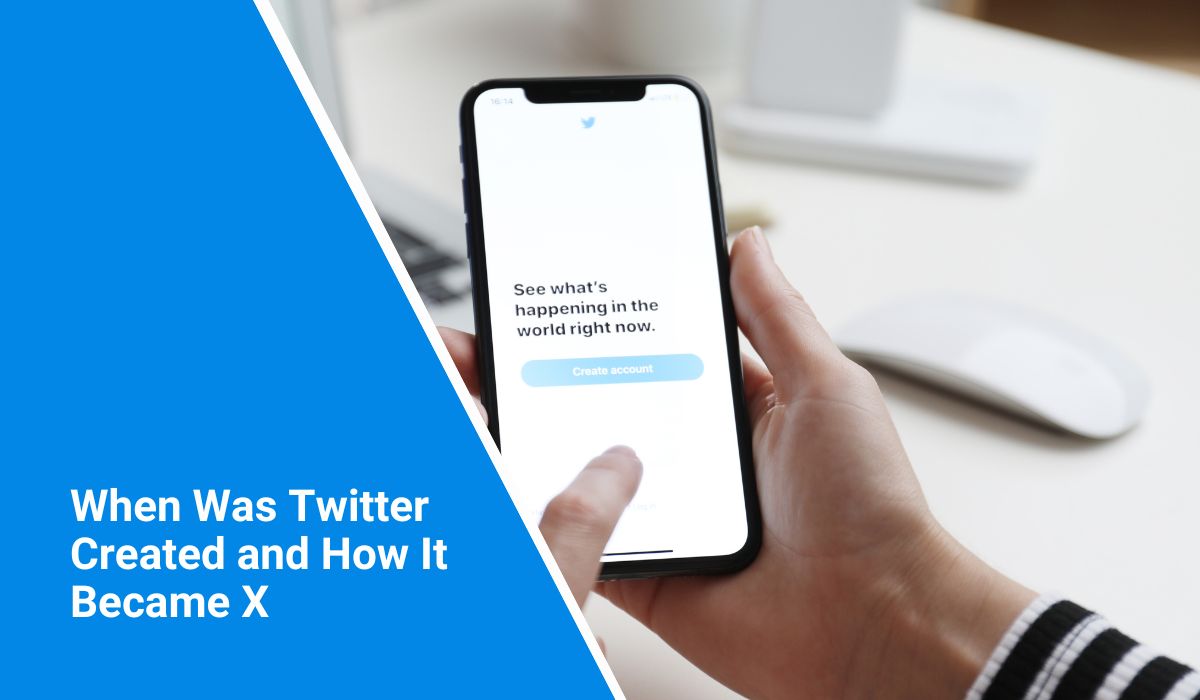For more than a decade, Twitter shaped how people shared news, opinions, and trends around the world. What started as a small idea inside a podcasting company became one of the most influential social platforms ever made. In 2023, it changed again, Twitter became X, a rebrand led by Elon Musk that aimed to transform the platform into something much bigger.
Let’s look at when Twitter started, how it grew, and how it eventually became what we now call X.
When Was Twitter Created?
Twitter was officially created on March 21, 2006, in San Francisco, California. The idea came from a small group of developers working at a podcasting company called Odeo. They wanted a way to send short, simple updates to friends in real time.
The first tweet ever sent was by Jack Dorsey, one of the company’s founders. It read: “just setting up my twttr.” This message marked the beginning of what would become a global communication network.
Who Founded Twitter?
 Jack Dorsey, Biz Stone, Noah Glass, and Evan Williams founded Twitter. Their goal was to build a microblogging platform, a space where people could post short updates, limited to 140 characters, so information could move quickly.
Jack Dorsey, Biz Stone, Noah Glass, and Evan Williams founded Twitter. Their goal was to build a microblogging platform, a space where people could post short updates, limited to 140 characters, so information could move quickly.
The idea spread fast. In a time before smartphones were everywhere, Twitter made it easy for users to stay connected through short text messages.
Early Growth and How Twitter Became Popular
Twitter started gaining real attention in 2007 at the South by Southwest (SXSW) festival, where live tweeting events became popular. People loved how fast information could spread. Soon after, features like hashtags (#), mentions (@), and retweets (RT) became part of the platform’s culture.
By 2010, Twitter was not just another social media site; it was a hub for breaking news, viral moments, and live discussions. It played a major role in global events, sports coverage, and even political movements.
Twitter’s Role in News and Global Communication
Over the years, Twitter became the place where information spread first. Journalists used it to share breaking stories, politicians used it to make announcements, and everyday users shared opinions instantly.
During the Arab Spring in 2011, activists used Twitter to organize and share updates with the world. From political debates to live sports commentary, Twitter became a digital public square a place where voices of all kinds could be heard.
Elon Musk Buys Twitter
In October 2022, Elon Musk, CEO of Tesla and SpaceX, bought Twitter for $44 billion. Musk said his main goals were to protect free speech, reduce spam bots, and make the platform more open and transparent.
After taking control, he introduced changes such as Twitter Blue, a subscription that allowed users to pay for verification and extra features. Musk also reorganized the company, restructured its staff, and began talking about turning Twitter into a new kind of social platform.
Why Twitter Became X
 In July 2023, Musk began rebranding Twitter to X. The blue bird logo was replaced with a simple X symbol, and the company officially changed its name to X Corp.
In July 2023, Musk began rebranding Twitter to X. The blue bird logo was replaced with a simple X symbol, and the company officially changed its name to X Corp.
The letter “X” has been a big part of Musk’s career, from his early online banking company X.com (which later became PayPal) to SpaceX and X Holdings. Musk said he wanted X to become an “everything app” that combines social media, payments, audio, video, and even AI tools into one platform.
He described it as the future of digital communication, aiming to compete not just with social media, but also with banking and streaming services.
What Changed After the Rebrand
After the switch from Twitter to X, several things changed:
- The famous bluebird logo disappeared, replaced by the bold X symbol.
- Tweets became posts, and retweets became reposts.
- Twitter Blue turned into X Premium, offering longer posts, ad revenue sharing, and verification badges.
- The platform started focusing more on videos, creators, and monetization.
- Musk also announced plans for X Payments and AI-powered tools.
Despite the new name and look, most core features, including following, posting, liking, and messaging, stayed the same.
Reactions and the Future of X
The rebrand to X brought mixed reactions. Some users embraced the new direction, calling it bold and forward-thinking. Others said they still preferred the name Twitter, seeing the change as the end of an era.
Musk’s long-term plan is to turn X into a universal platform, a place where people can communicate, share media, make payments, and manage everything in one app. He compared the concept to WeChat, China’s all-in-one social and payment app.
The company is also developing AI features, including the chatbot Grok, through xAI, Musk’s artificial intelligence venture.
Conclusion: From 140 Characters to an Everything App
Twitter began in 2006 as a short messaging idea shared among friends. Over time, it became a cultural and political powerhouse, a platform that changed how the world communicates.
Now, under Elon Musk, Twitter has evolved into X, an ambitious project aiming to redefine what a social network can be. Whether people call it Twitter or X, its influence on global communication is undeniable, and its next chapter is only just beginning.



